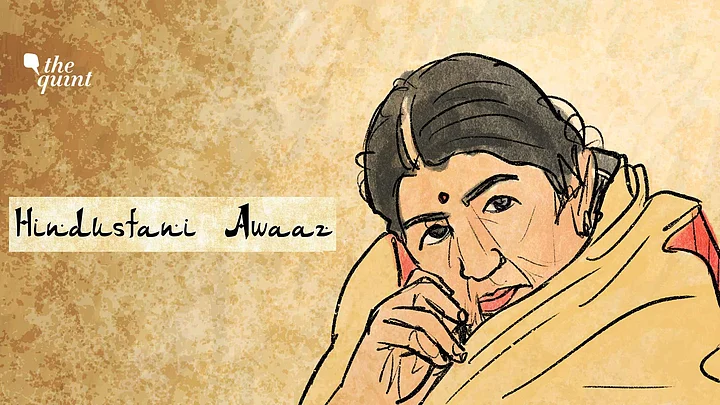It must have been sometime in 1947 or 1948 when Hindi cinema’s most iconic actor Dilip Kumar was still not so well-recognised as to get mobbed, and could easily travel to work in Bombay’s trains.
One day, the music director Anil Biswas, Dilip Kumar, and Lata Mangeshkar found themselves travelling in the same train compartment.
Lata's Encounter With Dilip Kumar
Dilip Kumar asked Anil Biswas about the young girl, to which he said, she was a young singer who sang well.
Dilip Kumar asked her name and where she was from. Biswas told the name and that she was from Maharashtra. Dilip Kumar’s response was: "But their Urdu pronunciation isn’t correct and in their singing you can smell daal-bhaat."
In today’s India, reading about this encounter in the excellent book Lata in Her Own Voice…. Conversations with Nasreen Munni Kabir (Niyogi Books), I find Dilip Kumar’s response incredible.
That he could make such a statement and not worry about political correctness speaks of an India where people were possibly less uptight about regional identities and took statements such as this at face value without over-reading them or taking offence. It also speaks of an India where Urdu had not been demonised, and knowing Urdu and speaking it correctly and well was a matter of pride not subversion.
Lata's Determination To Learn Urdu
However, what is most incredible is Lata Mangeshkar’s response to Dilip Kumar’s somewhat blithe statement. In her conversation with Nasreen Munni Kabir, she confesses to being terribly hurt at hearing such a thing. But, knowing how important it was to know Urdu as a singer in the Hindi film industry, she found merit in these harsh words and chose to do something about it.
She knew the composer Mohammad Shafi who worked as an assistant to Anil Biswas and Naushad. She told him that she wanted to learn Urdu so she could pronounce it correctly. Shafi found her a maulana, a gentleman called Mehboob, who taught her Urdu for a short while.
As Lata went on to say,
"When I speak, my Urdu isn’t very good but when I sing I make sure there are no flaws in my diction."
And so it was, that instead of being aggrieved or taking the high road of language chauvinism or parochialism, Lata strove to better herself.
The bell-like clarity of her voice may well have been a gift from God, honed by hours and hours of riyaaz, but the immaculate pronunciation, the correct emphasis on the ‘sound’ of words were all her own doing.
When singing in languages not her own, such as Urdu or Bangla or Tamil, she would first listen to someone who spoke the language read out the lyrics to her.
She would then write the words phonetically in Hindi and proceed to sing it, giving as much importance to words as tunes in her entire musical career.
Those who have worked with Lata vouch for the fact that she tried to understand the meanings of difficult Urdu words and expressions and not just mimic their correct pronunciation.
Possibly this understanding makes her sing Jan Nisar Akhtar’s Ai Dil-e Nadaan in ‘Razia Sultan’ or Aap Yun Faaslon se Guzarte Rahey for the little-known ‘Shankar Hussain’ with such a wealth of feeling.
Lata's Ghazals
Then there are the many ghazals in the classical mould such as this by Sahir Ludhianvi for the film ‘Ghazal’, the ghazal which should be sung differently from a song, given the compact brevity of the two-line sher that string it together, so that the meaning of each sher is understable:
Naghma-o sher ki saughat kisey pesh karoon
Yeh chhalkatey huwey jazbaat kisey pesh karoon
Or this by Majrooh Sultanpuri for ‘Dastak’:
Hum hain mataa-i koocha bazaar ki tarah
Utthti hai har nigaah kharidaar ki tarah
Or this by Naqsh Lyallpuri for ‘Dard’:
Ahl-e dil yuun hii nibha lete hain
Dard seene mein chhupa lete hain
Then there is the tender ghazal by Makhdoom Mohiuddin she sang for ‘Bazaar’:
Phir chhirhi raat baat phoolon ki
Shaam phulon kis raat phoolon ki
A veritable treasure trove of non-film ghazals sung by Lata and the late Jagjit Singh is to be found in the album Sajda beginning with this gem by Qateel Shifai:
Dard se mera daaman bhar de Ya Allah
Phir chahe diwana kar de Ya Allah
No mention of Lata singing the Urdu ghazal can be complete without noting the ghazals she sang of Ghalib. Of the many to be found online, here is a particular favourite:
Phir mujhe deeda-e tar yaad aaya
Dil jigar tishna-e faryaad aaya
If ever there can be an apt tribute for the Nightingale of India, it is this sher by Momin Khan Momin:
Uss ġhairat-e-nahid kihar taan hai dipak
Shala sa lapak jaaye hai awaaz to dekho
(Dr Rakhshanda Jalil is a writer, translator and literary historian. She writes on literature, culture and society. She runs Hindustani Awaaz, an organisation devoted to the popularisation of Urdu literature. She tweets at @RakhshandaJalil. This is an opinion piece and the views expressed above are the author’s own. The Quint neither endorses nor is responsible for the same.)
